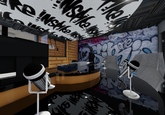1. Do Some Presentation Preparation Work
A good presentation begins, not with slides, but with a pencil and paper. Research your audience’s background, interests and capabilities. What do they already know, for instance, and what can they learn from you?
You also need to plan and outline a compelling story that both engages people and delivers your message. Like all good stories, it must have a beginning, middle, and end. Heroes and villains can help to pique interest. And the story should be relatable to your audience, in terms of tone, the language you use (for example, jargon and acronyms) and the slide images you choose.
2. Create Sleek and Stylish Slides
Once you have your story down, you can start to design your slides.
Before you do, it’s important to think about the practicalities. Will they, for instance, be displayed Widescreen with a 16:9 ratio? Or Standard with 4:3? This might seem like a small detail, but it can make a huge difference in terms of visual impact. If the room is bright, create slides with a light background and dark text. Conversely, if the room is dark, dark slides with bright images and text will work best.
Consistency is also important. Each slide heading should have the same font, font size and placement on the page. Use no more than two fonts, or your presentation may look messy. And choose your font style carefully. Serif typefaces, like Times New Roman, are fine in books, but slides look best with a sleek sans-serif font.
At all costs, avoid using bad art, stock photos, default slide templates, and pointless animations. These can cheapen your message and often look amateurish.
3. Get Your Audience to Focus
The most important thing is to grab your audience’s attention straight away – and then maintain it! You want your audience to go away having learned something. So, make it as easy as possible for people to grasp your message “from the off”!
In his Ted Talk above, entitled “How to Avoid Death by Powerpoint,” professional training and coaching expert David JP Phillips recommends that presenters focus on one key message per slide, and include no more than six objects (or lines) on each. Any more than this, he argues, and you will increase the time that it takes for people to “see” (and digest) information by 500 per cent.
Use contrast to direct your audience’s attention where you want it. People naturally focus on moving objects, larger text, and strong contrasts. They are also drawn to signalling colours, like red, orange and yellow. So, bear these factors in mind when you come to design your slides.



_165x115_fc3.jpg)




